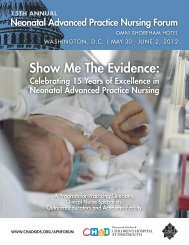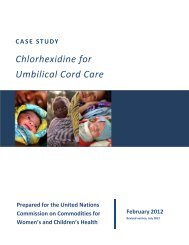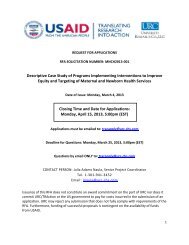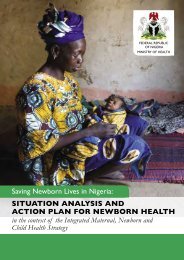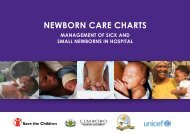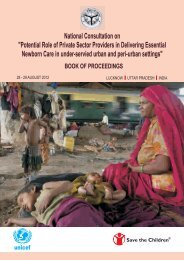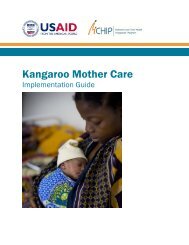A Systematic Review and Meta-analysis of Evidence - Healthy ...
A Systematic Review and Meta-analysis of Evidence - Healthy ...
A Systematic Review and Meta-analysis of Evidence - Healthy ...
You also want an ePaper? Increase the reach of your titles
YUMPU automatically turns print PDFs into web optimized ePapers that Google loves.
GOGIA, et al.<br />
is also dependent on the ratio <strong>of</strong> health worker to<br />
population. Azad’s trial which had 1 community<br />
worker per 1414 population [23] documented less<br />
reduction in NMR compared to trials with a better<br />
ratio [24,25]. This suggests that population coverage<br />
<strong>and</strong> the proportion <strong>of</strong> newly pregnant women<br />
enrolled in groups might need threshold levels to<br />
have an effect on birth outcomes (perhaps <strong>of</strong> the<br />
order <strong>of</strong> one group per 450-750 population, <strong>and</strong><br />
between 30% <strong>and</strong> 50% <strong>of</strong> newly pregnant women<br />
attending groups, respectively) [23]. The enrolment<br />
<strong>of</strong> newly pregnant women is likely to be a key determinant<br />
<strong>of</strong> the effectiveness <strong>of</strong> interventions<br />
involving women’s groups. It is important to<br />
underst<strong>and</strong> that as the NMR decreases in an area, the<br />
cause specific mortality due to sepsis decreases,<br />
asphyxia probably remains unchanged, <strong>and</strong><br />
proportion <strong>of</strong> mortality due to preterm birth (as well<br />
as absolute number) increases. Whether addition <strong>of</strong><br />
sepsis treatment with oral or injectable antibiotics<br />
can decreases the cause specific mortality further is<br />
not clear. Besides, there are legal <strong>and</strong> ethical issues<br />
<strong>of</strong> allowing these health workers to treat newborns<br />
with antibiotics which must be resolved before this<br />
component <strong>of</strong> the home based intervention can be<br />
taken to scale. The issue <strong>of</strong> whether mortality due to<br />
asphyxia can be decreased by providing training <strong>and</strong><br />
equipment to a community health worker has<br />
produced equivocal results [14-22, 29]. Since CHWs<br />
are likely to encounter asphyxia sporadically;<br />
continued training for maintenance <strong>of</strong> skills to<br />
manage asphyxia may be a challenging task.<br />
Overall completeness <strong>and</strong> applicability <strong>of</strong><br />
evidence<br />
The studies were conducted in participants <strong>and</strong><br />
settings directly relevant to the review. A total <strong>of</strong> 13<br />
controlled trials involving about 192000 births were<br />
included in this systematic review; the identified<br />
studies thus sufficiently addressed the main question<br />
<strong>of</strong> the review. Most <strong>of</strong> the reviewed studies did not<br />
report the complete description <strong>and</strong> characteristics <strong>of</strong><br />
intervention as well as the training, supervision,<br />
remuneration <strong>and</strong> motivation <strong>of</strong> CHWs. This information<br />
would be <strong>of</strong> great importance in underst<strong>and</strong>ing<br />
if <strong>and</strong> how these factors affect the<br />
performance <strong>of</strong> CHWs in operational settings. The<br />
heterogeneity <strong>and</strong> paucity <strong>of</strong> studies prevented<br />
COMMUNITY BASED NEWBORN CARE<br />
assessment <strong>of</strong> each component <strong>of</strong> the intervention<br />
package (health education, community mobilization,<br />
home visits, curative care etc) <strong>and</strong> its corresponding<br />
effect on neonatal mortality. The review did not<br />
include assessment <strong>of</strong> effect <strong>of</strong> community based<br />
neonatal care on early or late neonatal mortality <strong>and</strong><br />
cause specific neonatal mortality rates. With a<br />
sudden increase in number <strong>of</strong> institutional deliveries<br />
due to Janani Surakha Yojana, it would be worthwhile<br />
to assess the need to modify the community<br />
based neonatal care interventions to maximize the<br />
gains in neonatal survival.<br />
Quality <strong>of</strong> the evidence<br />
Assessment <strong>of</strong> risk <strong>of</strong> bias in included studies<br />
suggests adequate sequence generation in majority<br />
<strong>of</strong> studies. Allocation concealment is usually not an<br />
issue in cluster r<strong>and</strong>omized intervention trials as all<br />
the clusters are r<strong>and</strong>omized at once. Given the type<br />
<strong>of</strong> intervention, trials cannot possibly involve<br />
blinding <strong>of</strong> the participants. Similarly, with mortality<br />
as the primary outcome, blinding <strong>of</strong> outcome<br />
assessors is desirable but its absence cannot<br />
downgrade the strength <strong>of</strong> evidence. The risk <strong>of</strong> bias<br />
in the included trials is largely from an inability to<br />
address incomplete outcome data. The included<br />
studies are largely free <strong>of</strong> selective reporting.<br />
Potential biases in the review process<br />
The main conclusion regarding neonatal mortality<br />
remained stable over the spectrum <strong>of</strong> pre-specified<br />
subgroup analyses. Analysis <strong>of</strong> 13 trials did not<br />
indicate evidence <strong>of</strong> publication bias. Cluster <strong>and</strong><br />
individually r<strong>and</strong>omized trials were appropriately<br />
combined by using generic inverse variance method<br />
<strong>of</strong> data entry, thus allowing the pooling <strong>of</strong> effects <strong>of</strong><br />
cluster r<strong>and</strong>omized trials <strong>and</strong> other controlled trials.<br />
Diligent efforts were made to include all relevant<br />
trials. The issue <strong>of</strong> significant heterogeneity among<br />
the trials was addressed by doing subgroup <strong>analysis</strong><br />
<strong>and</strong> metaregression using pre-specified variables.<br />
However, due to the small number <strong>of</strong> trials for metaregression<br />
<strong>analysis</strong>, the statistical power was limited.<br />
CONCLUSIONS<br />
Community newborn care through home visitation<br />
with/without community mobilization <strong>and</strong><br />
INDIAN PEDIATRICS 544 VOLUME 48 __ JULY 17, 2011




